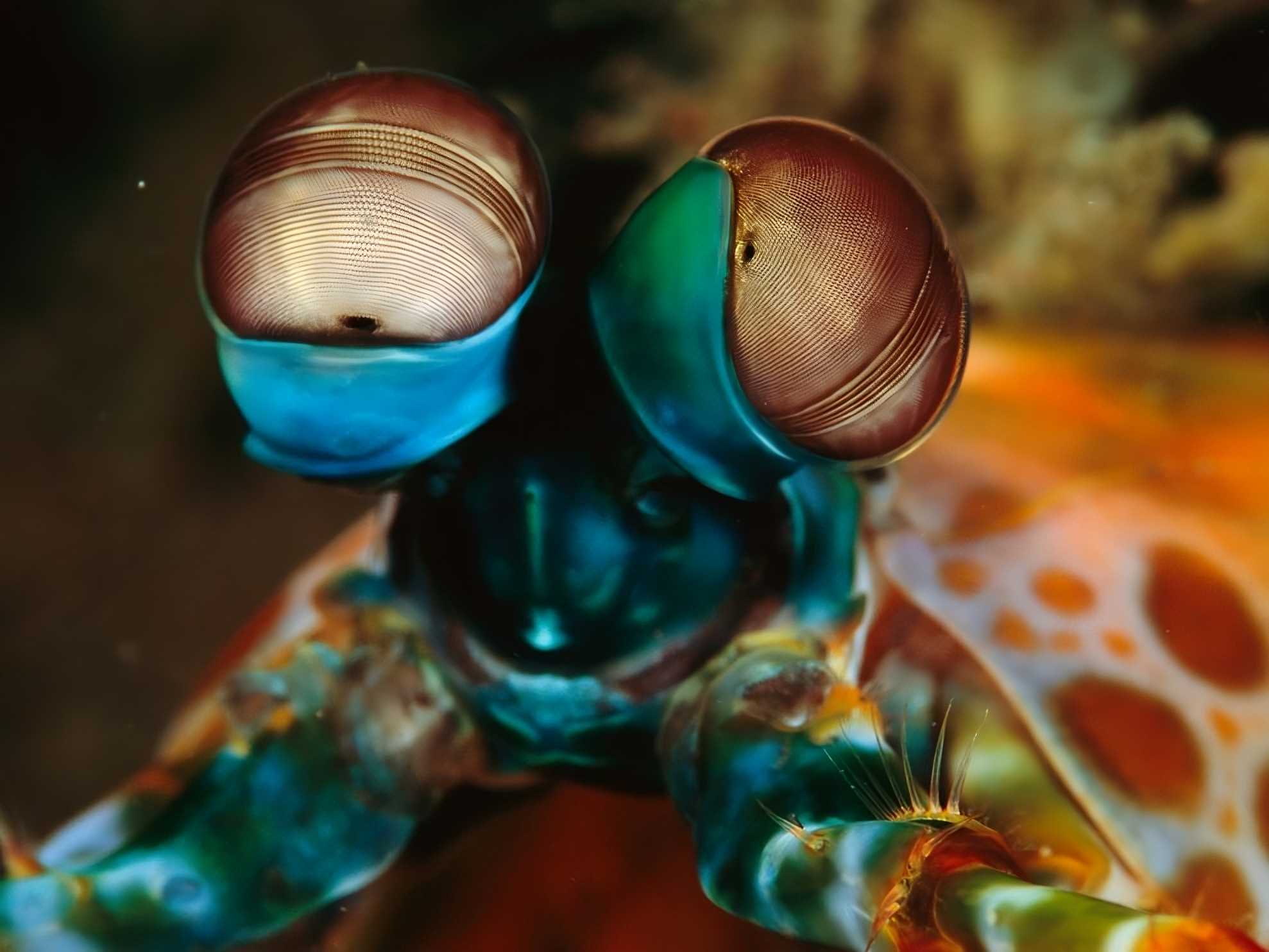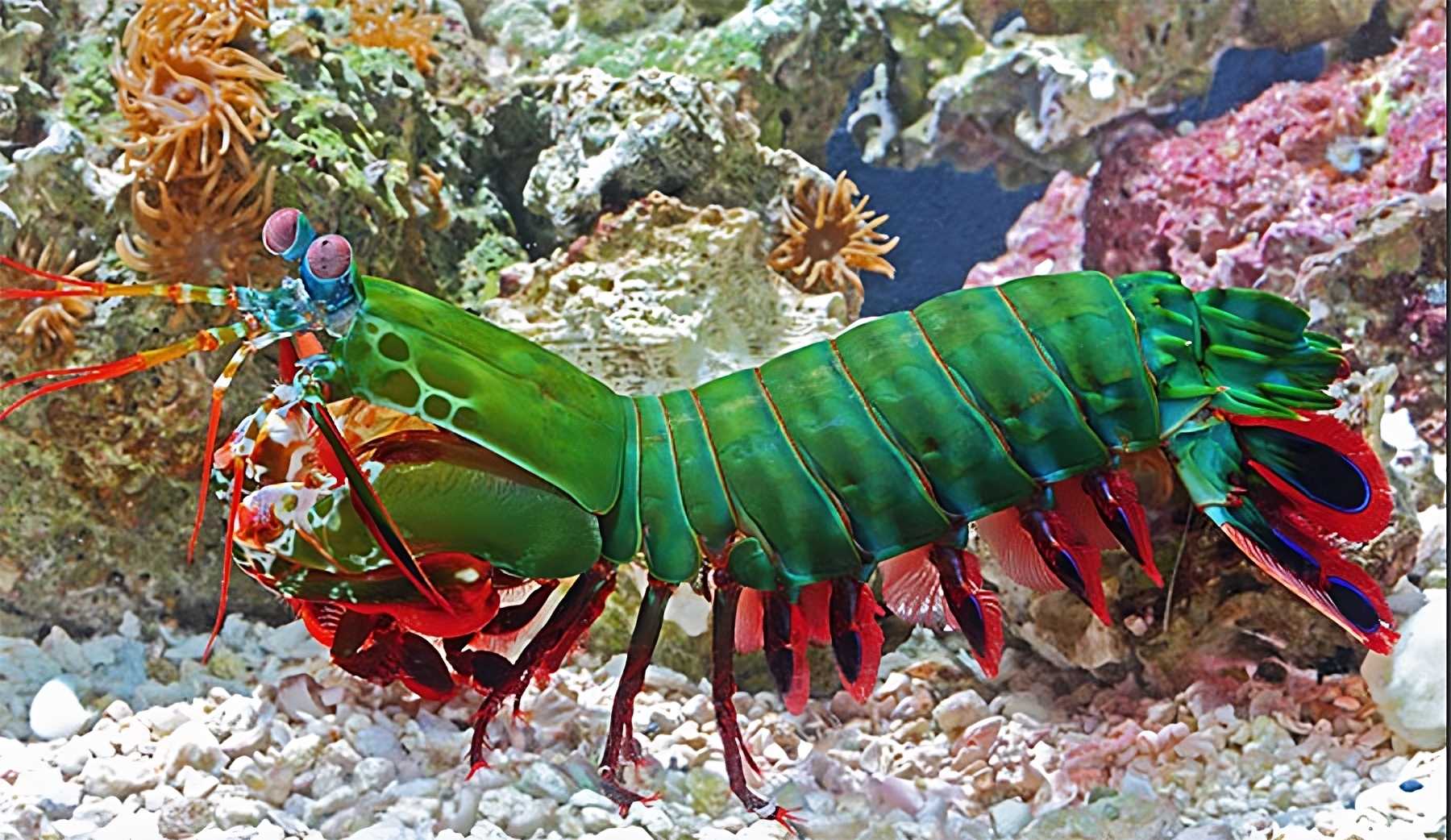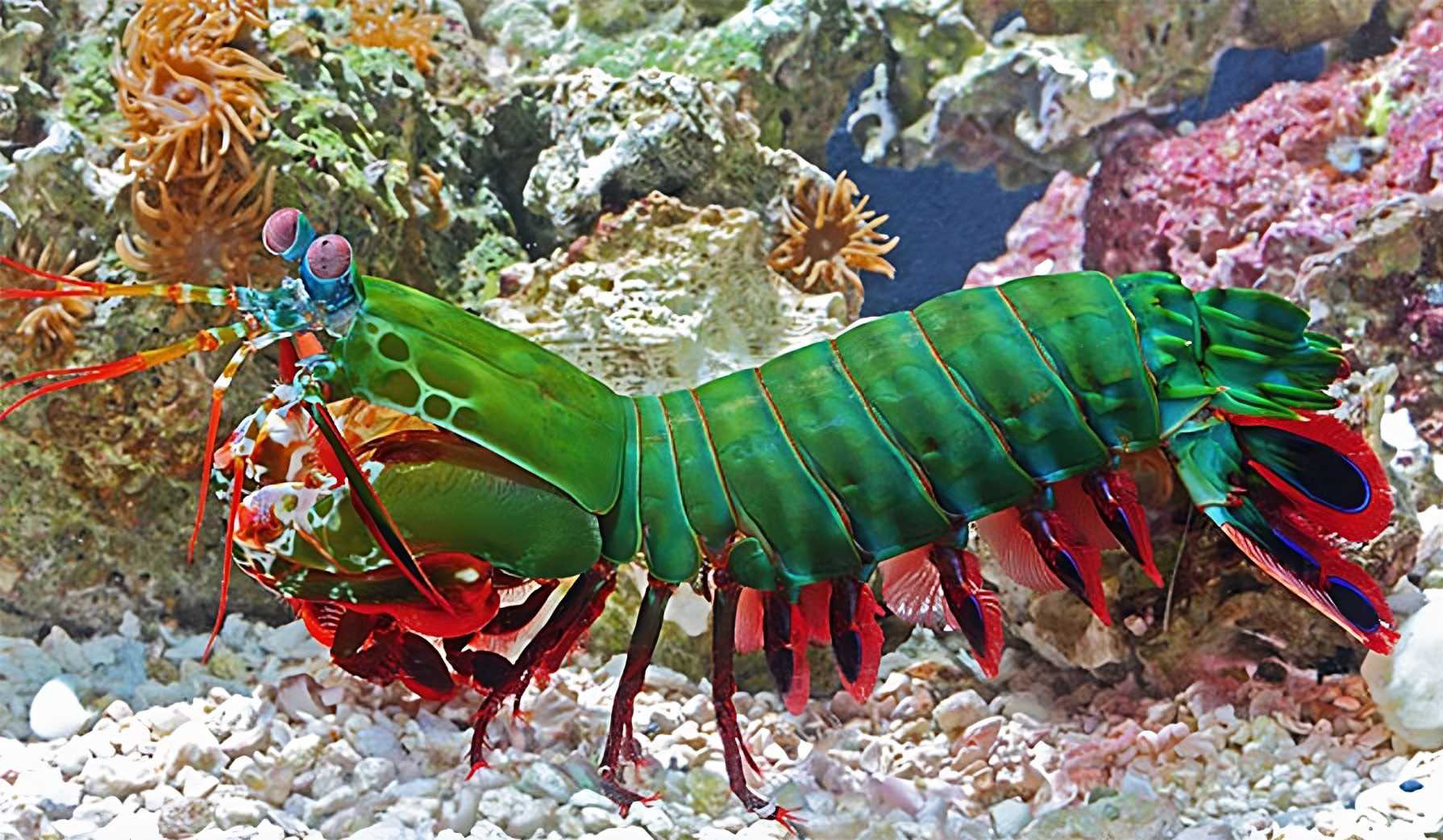The mantis shrimp, despite its name, is not a shrimp and is unrelated to the mantis. However, like them, it is an arthropod. Mantis shrimps belong to the general order Stomatopoda, which consists of approximately 500 different species. To differentiate them from true shrimps, mantis shrimps are sometimes referred to as stomatopods. These creatures are well-known for their powerful claws, which they use to capture their prey. The strength of their claws rivals that of an African lion’s jaws. In addition to their formidable hunting abilities, mantis shrimps possess exceptional eyesight, enabling them to perceive their surroundings with great acuity. Their rapid attacking movements can even cause the water around them to boil.
Characteristics of Mantis Shrimp

- Scientific name: Stomatopoda (e.g. Odontodactylus scyllarus)
- Other names: Mantis shrimp, sea grasshopper, finger-splitter, great shrimp killer
- Distinguishing features: Eyes with independently movable handles
- Average height 10 centimeters (maximum 38 cm)
- Diet: Carnivorous
- Lifespan: 20 years
- Habitat: Shallow tropical and subtropical marine environments
- Protection status Not measured
- Phylum: Arthropods
- Subphylum: Crustaceans
- Class: Malacostraca
- Order: Stomatopoda
- Fun fact: The attack of the mantis shrimp with its claw is strong enough to shatter aquarium glass.
There are over 500 species of mantis shrimp, displaying a wide range of sizes and colors. Like other crustaceans, mantis shrimp possess a protective shell. Their coloration varies from various shades of brown to striking rainbow hues. On average, adult mantis shrimp measure around 10 centimeters (approximately 3.9 inches) in length. However, there are individuals that can grow up to 38 centimeters (approximately 15 inches) long. In fact, there is a documented record of a mantis shrimp reaching a length of 46 centimeters (approximately 18 inches).
The Power of the Mantis Shrimp’s Punch
The claws of the mantis shrimp are its most remarkable feature. Depending on the species, the second pair of appendages resemble either mallets or spears. Mantis shrimps utilize their claws by either impaling or striking their prey with remarkable force. The strength and durability of their limbs have captivated researchers, who are studying the cell structure to design innovative body armor.
The attack of the mantis shrimp’s claws is astonishingly swift, comparable to a bullet from a .22-caliber rifle. Its prey often struggles to react in time. The mantis shrimp possesses the most powerful striking force in the animal kingdom. Its swift fist can reach speeds of 80 kilometers per hour (approximately 50 miles per hour) and deliver a force of 150 kilograms (approximately 330 pounds), which is 2,500 times its own body weight of merely 90 grams (approximately 0.2 pounds). A single strike from its club-like appendages can sever the arm of a crab or shatter the shell of a snail.
The Mantis Shrimp Eyesight
Mantis shrimps possess the most advanced eyesight in the animal kingdom, surpassing even the remarkable visual abilities of butterflies. While humans have three types of photoreceptor cells and butterflies have five, mantis shrimps boast an impressive range of 12 to 16 photoreceptor types.
In comparison, dogs have only green and blue color receptors, rendering them unable to perceive red. Humans, with their three color receptors for red, green, and blue, can observe a diverse range of colors including orange, yellow, and purple. However, the mantis shrimp’s eye, with its 16 photoreceptor types, unlocks a world of colors beyond our human perception, similar to butterflies.
While we enjoy the colors of the rainbow with our three photoreceptors, the mantis shrimp experiences an extraordinary array of colors when it beholds a rainbow, thanks to its diverse set of photoreceptors. The hundreds of new colors revealed by their 16 photoreceptors offer an unparalleled visual spectrum for these fascinating creatures.
“Moreover, certain mantis shrimp species possess the remarkable ability to adjust their sensitivity to different colors. The cluster of photoreceptors, known as ommatidia, is divided into three distinct regions arranged in parallel rows. This unique arrangement provides each eye with its own depth perception and trinocular vision, akin to an underdeveloped third eye.
Where Do Mantis Shrimp Live?

Mantis shrimp inhabit tropical and subtropical waters across the globe. The majority of species are found in the waters of the Indian and Pacific Oceans, which are their primary habitats. However, certain species can also be found in temperate marine environments, showcasing their adaptability. These fascinating stomatopods construct their nests in various shallow water habitats, including reefs, channels, and marshes, where they create their dwellings.
Diet and Hunting of Mantis Shrimp
The mantis shrimp, also known as a stomatopod, is primarily a reclusive predator. Different species exhibit distinct hunting strategies, with some actively stalking their prey while others patiently await their opportunity in a den. One remarkable ability of the mantis shrimp is its capacity to swing its predatory claws at astonishing speeds, reaching up to 82 kilometers per hour (22 meters per second). This lightning-fast movement, occurring in a mere 3000th of a second, generates such rapid force that it causes the water surrounding the shrimp and its target to boil and bubble. To put this in perspective, if a human were to move their arm at one-tenth of that speed, they could launch a ball held in their palm into outer space. The striking speed of a mantis shrimp’s claw is approximately 50 times faster than the duration of a human blink.
When the cavitation bubbles created by the mantis shrimp collapse, they generate a powerful shock wave that impacts the prey with a force of 1500 newtons (equivalent to 150 kilograms). This means that even if the shrimp fails to make direct contact with its target, the resulting shockwave can stun or kill the prey. Furthermore, the collapsing bubbles elevate the surrounding water to temperatures reaching thousands of degrees Celsius, making it as hot as the surface of the Sun. Additionally, this process produces a faint light known as sonoluminescence.
Mantis shrimps have a diverse diet that includes fish, snails, crabs, clams, and other mollusks. Surprisingly, they are also known to consume individuals of their own species.
Intelligence and Family Structure of Mantis Shrimp

Mantis shrimps display remarkable intelligence, exhibiting the ability to recognize and remember other animals through their keen sense of sight and smell. They also possess the capacity to learn and adapt. Intriguingly, these creatures engage in ongoing ceremonial fights and participate in complex coordinated activities, particularly within monogamous pairs. Through the use of fluorescent patterns, they communicate and signal to each other, and sometimes even to other species. This rich repertoire of behavior suggests the existence of a fascinating and communication system among mantis shrimps.
Lifespan and Reproduction of Mantis Shrimp
On average, mantis shrimp have a lifespan of about 20 years, during which they can reproduce approximately 20 to 30 times. In certain species, male and female mantis shrimps only interact during the mating process. The female either lays her eggs in a nest or carries them with her. In contrast, some species form lifelong monogamous bonds, with both male and female partners jointly caring for the eggs. After hatching, the young mantis shrimp exist as larvae in a planktonic form for around three months until they reach their adult form.
During the mating period, the male mantis shrimp emits a distinct sound, often resembling a grunt. This sound is believed to attract potential mates and possibly provoke rivals, serving as a form of communication in their reproductive behavior.
Animals That Can Hunt Mantis Shrim

The text appears to be grammatically correct. However, here are a few suggestions to enhance clarity and style:
A range of animals, including jellyfish, fish, and whales, prey on newly hatched zooplankton and juvenile mantis shrimps. However, once the mantis shrimp reaches its adult form, there are relatively few predators that pose a threat.
It’s worth noting that several species of mantis shrimp are consumed as seafood. The taste of mantis shrimp meat is often likened to that of lobsters rather than shrimps. However, it is important to be aware that consuming mantis shrimp, like any seafood, carries potential risks if sourced from polluted waters.
Mantis Shrimp Conservation Status
Mantis shrimp, with over 500 described species, remain relatively understudied due to their habitat preferences, as they spend the majority of their time within burrows. Consequently, comprehensive population assessments and conservation status evaluations are yet to be conducted.
Certain species of mantis shrimp are found in aquarium settings. However, they are generally considered undesirable due to occasional predatory behavior towards other tank inhabitants and their ability to break aquarium glass with their powerful claws. Nevertheless, the strikingly vibrant colors, remarkable intelligence, and the ability to create holes in live rock make mantis shrimp intriguing and captivating creatures that attract attention.
Mantis Shrimp at a Glance
How Strong is the Punch of Mantis Shrimp?
Why is Mantis Shrimp so Special?
Does the Mantis Shrimp Hurt People?
It is worth noting that mantis shrimps have gained a reputation that instills fear among fishermen, and there have been occasional anecdotal reports of human injuries caused by these remarkable crustaceans.
